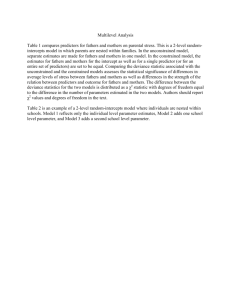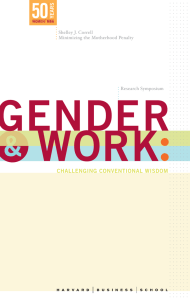Claire Cain Miller, “The Motherhood Penalty v. the Fatherhood Bonus.”
advertisement
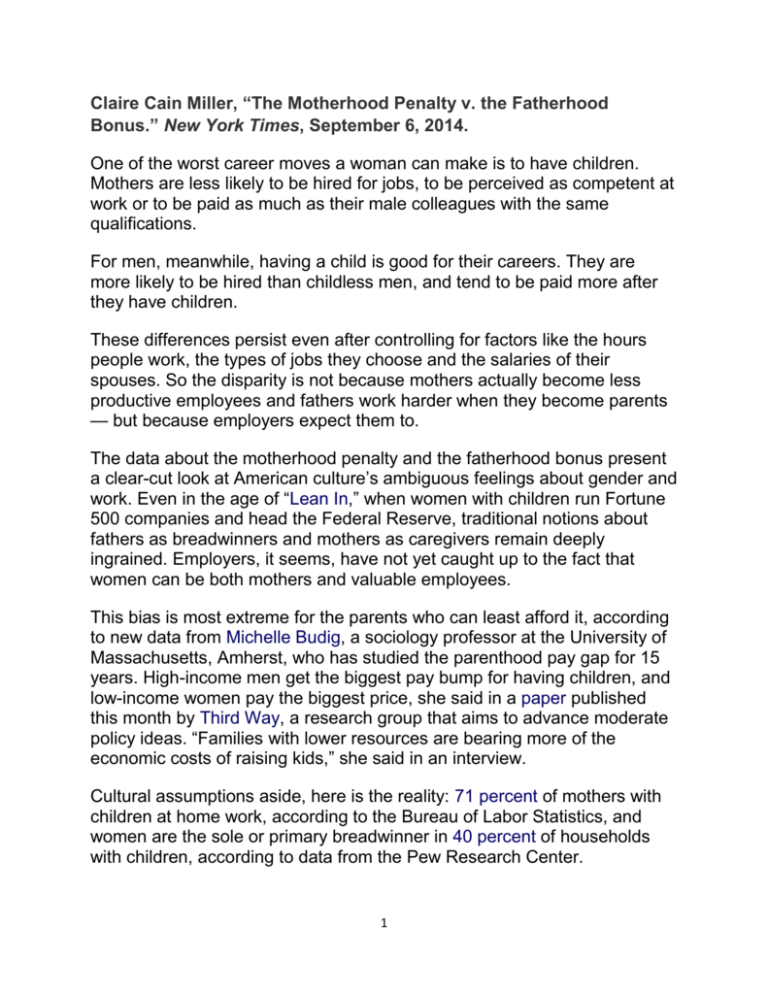
Claire Cain Miller, “The Motherhood Penalty v. the Fatherhood Bonus.” New York Times, September 6, 2014. One of the worst career moves a woman can make is to have children. Mothers are less likely to be hired for jobs, to be perceived as competent at work or to be paid as much as their male colleagues with the same qualifications. For men, meanwhile, having a child is good for their careers. They are more likely to be hired than childless men, and tend to be paid more after they have children. These differences persist even after controlling for factors like the hours people work, the types of jobs they choose and the salaries of their spouses. So the disparity is not because mothers actually become less productive employees and fathers work harder when they become parents — but because employers expect them to. The data about the motherhood penalty and the fatherhood bonus present a clear-cut look at American culture’s ambiguous feelings about gender and work. Even in the age of “Lean In,” when women with children run Fortune 500 companies and head the Federal Reserve, traditional notions about fathers as breadwinners and mothers as caregivers remain deeply ingrained. Employers, it seems, have not yet caught up to the fact that women can be both mothers and valuable employees. This bias is most extreme for the parents who can least afford it, according to new data from Michelle Budig, a sociology professor at the University of Massachusetts, Amherst, who has studied the parenthood pay gap for 15 years. High-income men get the biggest pay bump for having children, and low-income women pay the biggest price, she said in a paper published this month by Third Way, a research group that aims to advance moderate policy ideas. “Families with lower resources are bearing more of the economic costs of raising kids,” she said in an interview. Cultural assumptions aside, here is the reality: 71 percent of mothers with children at home work, according to the Bureau of Labor Statistics, and women are the sole or primary breadwinner in 40 percent of households with children, according to data from the Pew Research Center. 1 Yet much of the pay gap seems to arise from old-fashioned notions about parenthood. “Employers read fathers as more stable and committed to their work; they have a family to provide for, so they’re less likely to be flaky,” Ms. Budig said. “That is the opposite of how parenthood by women is interpreted by employers. The conventional story is they work less and they’re more distractible when on the job.” Ms. Budig found that on average, men’s earnings increased more than 6 percent when they had children (if they lived with them), while women’s decreased 4 percent for each child they had. Her study was based on data from the National Longitudinal Survey of Youth from 1979 to 2006, which tracked people’s labor market activities over time. Childless, unmarried women earn 96 cents for every dollar a man earns, while married mothers earn 76 cents, widening the gap. The gap persisted even after Ms. Budig controlled for factors like experience, education, hours worked and spousal incomes. It’s true that fathers sometimes work more after children, but that explains at most 16 percent of their bonus, she found. And some mothers cut back on hours or accept lower-paying jobs that are more family-friendly, but that explains only a quarter to a third of the motherhood penalty. The majority of it, research suggests, is because of discrimination. “A lot of these effects really are very much due to a cultural bias against mothers,” said Shelley J. Correll, a sociology professor at Stanford University and director of the school’s Clayman Institute for Gender Research. Ms. Correll co-wrote a study at Cornell in which the researchers sent fake résumés to hundreds of employers. They were identical, except on some there was a line about being a member of the parent-teacher association, suggesting that the applicant was a parent. Mothers were half as likely to be called back, while fathers were called back slightly more often than the men whose résumés did not mention parenthood. In a similar study done in a laboratory, Ms. Correll asked participants how much they would pay job applicants if they were employers. Mothers were offered on average $11,000 less than childless women and $13,000 less than fathers. In her research, Ms. Correll found that employers rate fathers as the most desirable employees, followed by childless women, childless men and 2 finally mothers. They also hold mothers to harsher performance standards and are less lenient when they are late. There was one exception in Ms. Budig’s study: Women in the top 10 percent of earners lost no income when they had children, and those in the top 5 percent received bonuses, similar to men. She speculated that in these rarefied jobs, employers see high-performing women as more similar to men, and that women might work more and negotiate for higher pay in order to afford household and child care help. At the other end of the earnings spectrum, low-income women lost 6 percent in wages per child, two percentage points more than the average. For men, the largest bonuses went to white and Latino men who were highly educated and in professional jobs. The smallest pay bumps went to unmarried African-American men who had less education and had manual labor jobs. “The daddy bonus increases the earnings of men already privileged in the labor market,” Ms. Budig wrote. That low-income workers benefit the least or suffer the most economically from parenthood is perhaps not surprising. They are the least likely to have flexible schedules or benefits like paid parental leave. Low-wage women with children under 6, when offspring need the most in-person care, paid a wage penalty five times as great as that of higher-paid women with young children, Ms. Budig found. The data could be boiled down to hardheaded career advice: Men should festoon their desks with baby photos and add PTA membership to their résumés, and women should do the opposite. But ultimately, the solution is a realization that in the 21st century, male and female employees are not so different from one another. “The best hope we have for getting rid of these effects,” Ms. Correll said, “is policy that very much conveys that people have the right to coordinate work and family.” In Ms. Budig’s previous work, she has found that two policies shrink the motherhood penalty: publicly funded, high-quality child care for babies and toddlers, and moderate-length paid parental leave. For instance, in countries that promote more traditional gender roles, like Germany, where new mothers are expected to take more than a year off work, the motherhood penalty is very high. Countries like Sweden with more 3 progressive policies, such as incentives for new fathers to also take leave, have a smaller pay gap. In the United States, most people eventually have children. That is a reality that employers should understand — as is the fact that now, fathers, too, change diapers and pack lunches and mothers go to work. 4
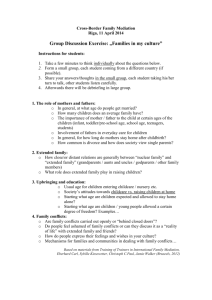


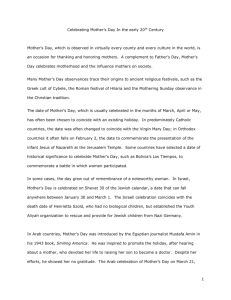
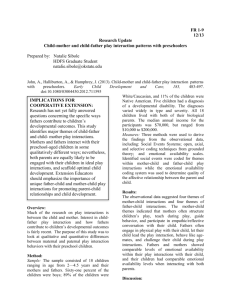
![Children`s mental health is parents` gre[...]](http://s3.studylib.net/store/data/007175392_1-8975cac3d2bf4181e48155b9fb82c0e2-300x300.png)

